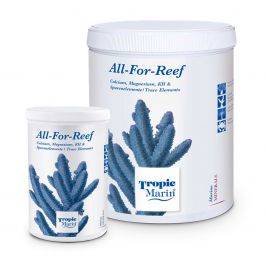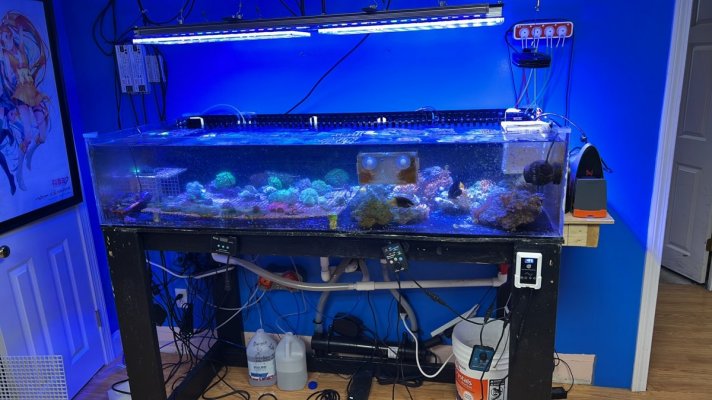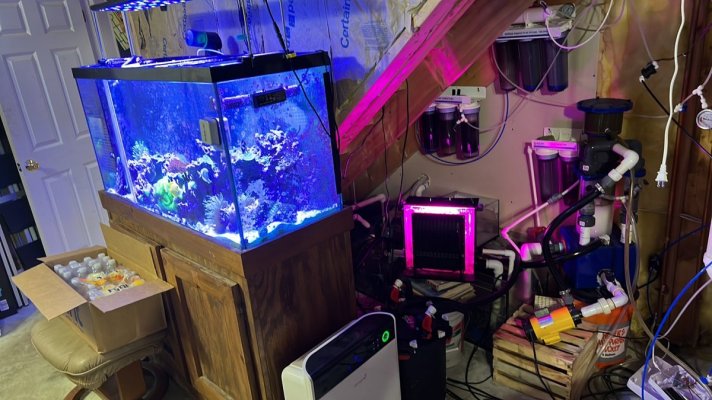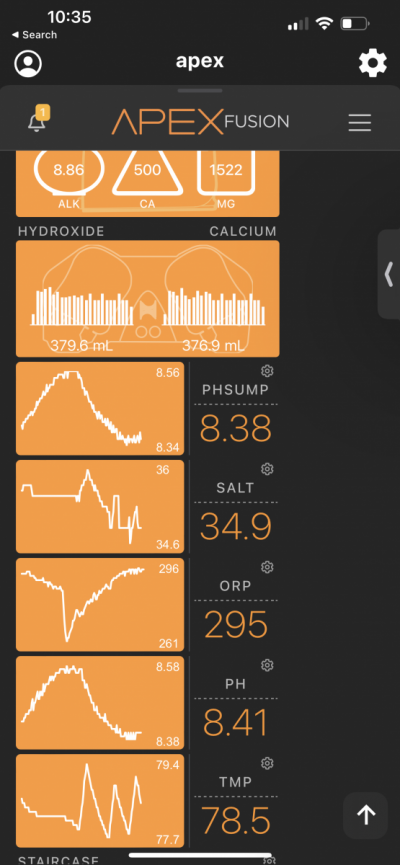currently im dosing 350ml of hydroxide and 375ml of calcium of the diy 2 part per day im wondering how much all for reef i would need (obviously the powder) just wondering caus the 70$ one would get me about 30 days and 70$ a month is quite a bit. would i need to dose less all for reef and would it be worth it. i dont do many water changes due to 300 gallon tank i usualy do around 15 gallons a week.
Navigation
Install the app
How to install the app on iOS
Follow along with the video below to see how to install our site as a web app on your home screen.
Note: This feature may not be available in some browsers.
More options
You are using an out of date browser. It may not display this or other websites correctly.
You should upgrade or use an alternative browser.
You should upgrade or use an alternative browser.
How much All for reef would i need?
- Thread starter Stormlasher
- Start date
- Tagged users None
I have seen this it has no coronation to the amount of afr to sodaash/hydroxide that’s what I’m looking for if I stop dosing hydroxide my tank can drop 2-3 dkh in 24 hrs so if I’m gona make a switch I was wondering what a comparable amount to amount would be
I think you'll have to make your best guess...I have seen this it has no coronation to the amount of afr to sodaash/hydroxide that’s what I’m looking for if I stop dosing hydroxide my tank can drop 2-3 dkh in 24 hrs so if I’m gona make a switch I was wondering what a comparable amount to amount would be
Randy Holmes-Farley
Reef Chemist
View Badges
Staff member
Super Moderator
Excellence Award
Expert Contributor
Article Contributor
R2R Research
My Tank Thread
- Joined
- Sep 5, 2014
- Messages
- 67,311
- Reaction score
- 63,658
I have seen this it has no coronation to the amount of afr to sodaash/hydroxide that’s what I’m looking for if I stop dosing hydroxide my tank can drop 2-3 dkh in 24 hrs so if I’m gona make a switch I was wondering what a comparable amount to amount would be
2-3 dKH a day is a lot of All for Reef.
The BRS site says the solution made from Al for Reef powder is 6,000 dKH.
Thus, 10 mL of All for Reef boosts a 100 L tank by 0.6 dKH.

All-For-Reef - Powder Mix
Tropic Marin All-For-Reef revolutionized aquarium additive dosing with their original pre-mixed solution, and now this same formula is available in an ultra-concentrated crystalline form that you can easily mix at home, making it more economical for systems of all sizes. All-For-Reef powder...
If that’s the case I’m probly better off sticking with hydroxide and supplement with afr I’m trying to find the best way to do trace elements when large water changes are a bit of a pain also it’s hard to tell why I use so much I don’t have an incredible amount of coral I mean it’s more then most but still it’s crazy how much I need now I mean some afr will be better then none but yeh it would be to costly monthly2-3 dKH a day is a lot of All for Reef.
The BRS site says the solution made from Al for Reef powder is 6,000 dKH.
Thus, 10 mL of All for Reef boosts a 100 L tank by 0.6 dKH.

All-For-Reef - Powder Mix
Tropic Marin All-For-Reef revolutionized aquarium additive dosing with their original pre-mixed solution, and now this same formula is available in an ultra-concentrated crystalline form that you can easily mix at home, making it more economical for systems of all sizes. All-For-Reef powder...www.bulkreefsupply.com
Attachments
This is currently what it is and trident needs to be calibrated current alk is 9.3 460calcium and 1470 magIf that’s the case I’m probly better off sticking with hydroxide and supplement with afr I’m trying to find the best way to do trace elements when large water changes are a bit of a pain also it’s hard to tell why I use so much I don’t have an incredible amount of coral I mean it’s more then most but still it’s crazy how much I need now I mean some afr will be better then none but yeh it would be to costly monthly
Attachments
2-3 dKH a day is a lot of All for Reef.
The BRS site says the solution made from Al for Reef powder is 6,000 dKH.
Thus, 10 mL of All for Reef boosts a 100 L tank by 0.6 dKH.

All-For-Reef - Powder Mix
Tropic Marin All-For-Reef revolutionized aquarium additive dosing with their original pre-mixed solution, and now this same formula is available in an ultra-concentrated crystalline form that you can easily mix at home, making it more economical for systems of all sizes. All-For-Reef powder...www.bulkreefsupply.com
Good info.
If that’s the case I’m probly better off sticking with hydroxide and supplement with afr I’m trying to find the best way to do trace elements when large water changes are a bit of a pain also it’s hard to tell why I use so much I don’t have an incredible amount of coral I mean it’s more then most but still it’s crazy how much I need now I mean some afr will be better then none but yeh it would be to costly monthly
This is more or less correct. Hobbyist have to decide what their limit is when dosing some products. In this case the largest container of powder AFR is 1600g. That makes 10 L I believe. So now calculate your starting dose using their calculator and go from there. For me that magic number falls between 100 - 120 ml/day. At that point I'll probably be better off going to esv 2 part and add in TM's C product.
That or use RHF recipes if I'm trying to save.
Randy Holmes-Farley
Reef Chemist
View Badges
Staff member
Super Moderator
Excellence Award
Expert Contributor
Article Contributor
R2R Research
My Tank Thread
- Joined
- Sep 5, 2014
- Messages
- 67,311
- Reaction score
- 63,658
FWIW, daily demand for alk and calcium may decline a lot when switching from a very high pH additive like hydroxide to a low pH additive like All for Reef.
I see because yeh I went from 280 to almost 400 when I started swinging to 8.6 ph peak the consumption went insane , I don’t see any precipitation but I refuse to believe the corals and coraline is drinking all of itFWIW, daily demand for alk and calcium may decline a lot when switching from a very high pH additive like hydroxide to a low pH additive like All for Reef.
I have a 180g system that I'm switching off BRS 2-part (calcium chloride/soda ash) next week to be replaced with AFR. I'm also a little concerned how economical it will be. I've seen comparable tanks in my area though that only use 25-50mL/day of AFR. At that rate you're talking maybe $150-300/year for the product. Considering how tired I am of 2-part wobbling up and down, that seems like a bargain. Following along to see what you choose.
Randy Holmes-Farley
Reef Chemist
View Badges
Staff member
Super Moderator
Excellence Award
Expert Contributor
Article Contributor
R2R Research
My Tank Thread
- Joined
- Sep 5, 2014
- Messages
- 67,311
- Reaction score
- 63,658
I have a 180g system that I'm switching off BRS 2-part (calcium chloride/soda ash) next week to be replaced with AFR. I'm also a little concerned how economical it will be. I've seen comparable tanks in my area though that only use 25-50mL/day of AFR. At that rate you're talking maybe $150-300/year for the product. Considering how tired I am of 2-part wobbling up and down, that seems like a bargain. Following along to see what you choose.
Wobbling? Why would a two part wobble when a one part will not?
I mean between the two timers. Dosers/timers are never accurate enough to keep it perfectly in balance so one is always sliding around on the other. That's always been my experience in the last six+ years of using 2-part. 1-part is already in ratio as I understand it and will only use one timer so this shouldn't happen.Wobbling? Why would a two part wobble when a one part will not?
- Joined
- Apr 10, 2009
- Messages
- 656
- Reaction score
- 1,349
Just two, very minor additions to what @Randy Holmes-Farley has already stated...FWIW, daily demand for alk and calcium may decline a lot when switching from a very high pH additive like hydroxide to a low pH additive like All for Reef.
1) Because AFR alkalinity is largely converted "in" the coral polyps (in addition to other locations), you don't always see the same kind of of increase in dkH in the water column like you do with soda ash or sodium bicarbonate. You can think of it as meeting the demand for the alkalinity the corals need directly, bypassing the normal resulting decrease you would see in the water dkH measurement. An easier way of looking at this is that AFR is much more effective in "maintaining" the already existing proper alkalinity, than "raising" a low alkalinity to the desired value.
2) I wouldn't call AFR a "low pH additive" as it is quite neutral in pH and just doesn't result in the pH increase that you will see with hydroxide additives. Think of AFR as an additive that does not influence pH up or down. This may result in a lower average pH in the system, if the previous hydroxide additions have been responsible for maintaining the higher pH.
Just two, very minor additions to what @Randy Holmes-Farley has already stated...
1) Because AFR alkalinity is largely converted "in" the coral polyps (in addition to other locations), you don't always see the same kind of of increase in dkH in the water column like you do with soda ash or sodium bicarbonate. You can think of it as meeting the demand for the alkalinity the corals need directly, bypassing the normal resulting decrease you would see in the water dkH measurement. An easier way of looking at this is that AFR is much more effective in "maintaining" the already existing proper alkalinity, than "raising" a low alkalinity to the desired value.
2) I wouldn't call AFR a "low pH additive" as it is quite neutral in pH and just doesn't result in the pH increase that you will see with hydroxide additives. Think of AFR as an additive that does not influence pH up or down. This may result in a lower average pH in the system, if the previous hydroxide additions have been responsible for maintaining the higher pH.
Hi @Lou Ekus - is there any chance of a larger powder offering? 1600g is the max now and I was curious if there is consideration of larger to maybe lower the cost a little more when exceeding 100 ml/day dose. Not sure if supply allows the offering yet or if it is practicle.
Thanks. Have a great day.
Randy Holmes-Farley
Reef Chemist
View Badges
Staff member
Super Moderator
Excellence Award
Expert Contributor
Article Contributor
R2R Research
My Tank Thread
- Joined
- Sep 5, 2014
- Messages
- 67,311
- Reaction score
- 63,658
My pH comment was by comparison to other alk additives, not that it is a cause of low pH.
Here’s what I mean in relative rank order, with bicarbonate and all for reef having a very small pH lowering effect:
CaCO3/CO2 reactor << acetate < bicarbonate = formate << carbonate << hydroxide
Here’s what I mean in relative rank order, with bicarbonate and all for reef having a very small pH lowering effect:
CaCO3/CO2 reactor << acetate < bicarbonate = formate << carbonate << hydroxide
- Joined
- Apr 10, 2009
- Messages
- 656
- Reaction score
- 1,349
Yes, @Randy Holmes-Farley I totally understood that. And I agree with you 100%. My comment was only meant to clarify for anyone that might have taken the comment of "comparison to a low pH additive like AFR" in the wrong way. No foul meant at all. Just a clarification.My pH comment was by comparison to other alk additives, not that it is a cause of low pH.
Here’s what I mean in relative rank order, with bicarbonate and all for reef having a very small pH lowering effect:
CaCO3/CO2 reactor << acetate < bicarbonate = formate << carbonate << hydroxide
- Joined
- Apr 10, 2009
- Messages
- 656
- Reaction score
- 1,349
Some people in our company, like Hans-Werner Balling for instance, prefer to use the alkalinity to monitor AFR dosage. You did hear me correctly, that I prefer to use the Ca as the dosage indicator. The reason for that is that many tanks, here in the US, tend to have some alkalinity consumption that is not related to a corresponding Ca consumption. In those instances, using the alkalinity would result in an much elevated Ca concentration. I very rarely see tanks that run in the opposite way. Hence, the reason for my preference.Lou, did I here you correctly on a live stream that with AFR it's better to monitor Calcium and dose to keep it where you want it rather than Akl?
- Joined
- Apr 10, 2009
- Messages
- 656
- Reaction score
- 1,349
The formate raw material is quite expensive. So even with much larger sizes, there is only minimal cost savings. However, if you are working with a LFS that happens to be a Tropic Marin Preferred Dealer (https://tropicmarin-usa.com/preferred-dealers.html) they can special order a 5 gallon bucket for you. In respect to cost, if you calculate the cost other additives adding up all the Ca, alkalinity, Mg and trace elements together, the actual relative cost of the AFR is quite reasonable. This is even true with the 1600 gm size.Hi @Lou Ekus - is there any chance of a larger powder offering? 1600g is the max now and I was curious if there is consideration of larger to maybe lower the cost a little more when exceeding 100 ml/day dose. Not sure if supply allows the offering yet or if it is practicle.
Thanks. Have a great day.
Similar threads
- Replies
- 21
- Views
- 160
- Replies
- 47
- Views
- 1,805
- Replies
- 14
- Views
- 368
- Replies
- 31
- Views
- 522
- Replies
- 7
- Views
- 440




















